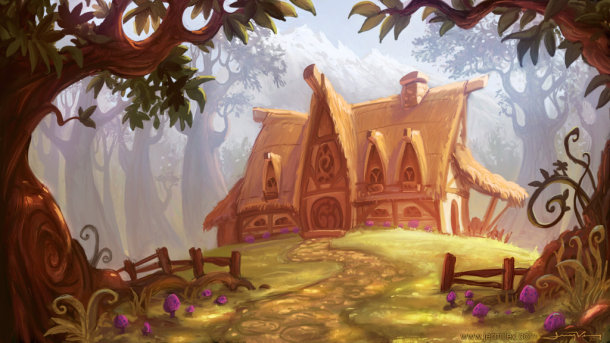Q&A: Jeremy Vickery, Pixar lighting guru
 Jeremy Vickery graduated with a degree in computer animation in 1997. His first job out of school was as a Modeling/Texturing Artist at Big Idea Productions in Chicago, working on the animated kids’ show Veggie Tales. He then worked as a CG Generalist and later as the Lighting Supervisor at Fathom Studios in Atlanta, on the “almost unknown film” Delgo. [Some of us remember it! – Ed.]
Jeremy Vickery graduated with a degree in computer animation in 1997. His first job out of school was as a Modeling/Texturing Artist at Big Idea Productions in Chicago, working on the animated kids’ show Veggie Tales. He then worked as a CG Generalist and later as the Lighting Supervisor at Fathom Studios in Atlanta, on the “almost unknown film” Delgo. [Some of us remember it! – Ed.]
In 2003 he joined Pixar Animation Studios as a Lighting Technical Director where he worked on the films The Incredibles, Cars, Ratatouille and Wall-E. After a stint working as a freelance artist for companies such as Disney, Sony, LEGO, and Ubisoft, he returned to Pixar in 2011, where he is currently working on the studio’s next film, Brave.
In his session on Effective Cinematic Lighting for the Gnomon School of Visual Effects’ online Master Classes, which go out from 5-19 December, Jeremy attempts to demystify this often overlooked art.
During the class, Jeremy will tackle 2D principles such as good composition and color keys, then proceed to techniques for lighting 3D illustrations, 3D character animation and film sequences. Although he uses Maya as his primary tool, the same principles hold true for any 3D application.
With the class due to go live next week, CG Channel caught up with Jeremy to find out more.
http://vimeo.com/32932173
Watch a preview video of Jeremy Vickery’s Gnomon Master Class. See the full session online next week.
CG Channel: If you had to give a five-word pitch for the class, what would it be?
JV: Jeremy Vickery: Learn composition and cinematic lighting!
CGC: So what do you most hope that people remember after finishing the class?
JV: I’m hoping that the principles of lighting for cinema are demystified a bit and that people will learn some methods for using light to help tell their stories.
And I hope it introduces many potential future lighting artists to this fun and obscure field.
CGC: ‘Obscure’ is probably the right word: I suspect a lot of people outside the industry think that lighting just happens by magic. Do you ever wish you worked in a showier discipline, like animation?
JV: In one way I love that lighting isn’t as ‘showy’ as animation. It makes me feel more like a magician than an actor: a bit more eccentric, if that doesn’t sound too proud.
There are definitely times where I feel lighting is overlooked – especially in education, when I see student demo reels – but I’ve tried my hand at many of the disciplines in this industry and lighting definitely suits me the best.
The only time I ever feel upset that lighting doesn’t get enough respect is when I see work done without any thought to color or light. So many productions spend their whole budget without a thought for lighting. (Really. I had a client who wanted me to light a 22-minute animated show in only 2 weeks… holy #%^$!)

A promotional image for LEGO’s online Christmas shop. An understanding of traditional art principles is key to good lighting, says Jeremy Vickery – whether you’re working on ads or animations.
CGC: So what skills to you need to be a good lighter?
JV: I suppose my masterclass will cover that… ha! But realistically, you should know core art principles through and through. You should know the principles of composition, color, light, mood, appeal and cinematic storytelling. It should run in your veins and be the motivation of everything you design.
Unfortunately, many students (and teachers) think that lighting is a purely technical task and go to learn software without building upon the foundation of design. It’s not that lighting isn’t technical as well, at least at this point in history, but it’s slowly becoming more and more of an artist’s craft and less of a technician’s job.
I foresee a day when illustrators and painters are hired to be lighting artists (many of us already are), instead of computer science majors. I suggest learning a fair amount of technology as well – but only as the icing on top of the cake of good artistic principles.
CGC: What advice would you give to a young artist hoping to follow in your footsteps?
JV: Do what you love with passion! If you focus on doing the things that you love to do, you will gain the patience to see it through until you are skilled enough to get paid to do it full time.
Spend more time creating than talking about creating. Eat, breathe and live your passion.
And don’t lose hope. This industry is small and difficult to break into. But if you continue to practise and create and get better at everything you do, you eventually get to the point where you can work anywhere you want.

The Charm Maker’s Cottage: a concept art image for Jeremy Vickery’s own short film.
CGC: What part of your working day most makes you think: ‘This is why I do this job?’
JV: When I see the movie up on the big screen and can know that I’ve contributed artistically to something that will be considered a ‘classic’. I still can’t believe I get paid to do what I do. When I go to Disney World with my family and see part of my blood, sweat and tears being enjoyed my millions of people, it’s unreal.
But honestly, when I’m sitting in review, surrounded by so many wonderfully talented artists and learning by osmosis from them all, that’s when I know I could do nothing else. And it helps that Pixar’s work environment is so creatively inspiring.
CGC: If you could wave a magic wand and change one thing about the profession, what would it be?
JV: Do you have a working magic wand? Can I borrow it for a while?
I’d like infinite processing power and not need a render farm. It seems our render times never drop, even though the farm is ten times the size it was eight years ago. No matter how fast the computers get or how much RAM we install, we still end up using it to the full.
But if I could have a real-time lighting engine that outputs film-quality images, that would be a good enough bit of magic for me. I’d love to focus completely on the art and not be encumbered by the technical limitations.
Visit Jeremy Vickery’s website
Visit the Gnomon website to enrol for the Master Classes ($295 for all 14 classes)
Full disclosure: CG Channel is owned by the Gnomon School of Visual Effects.
